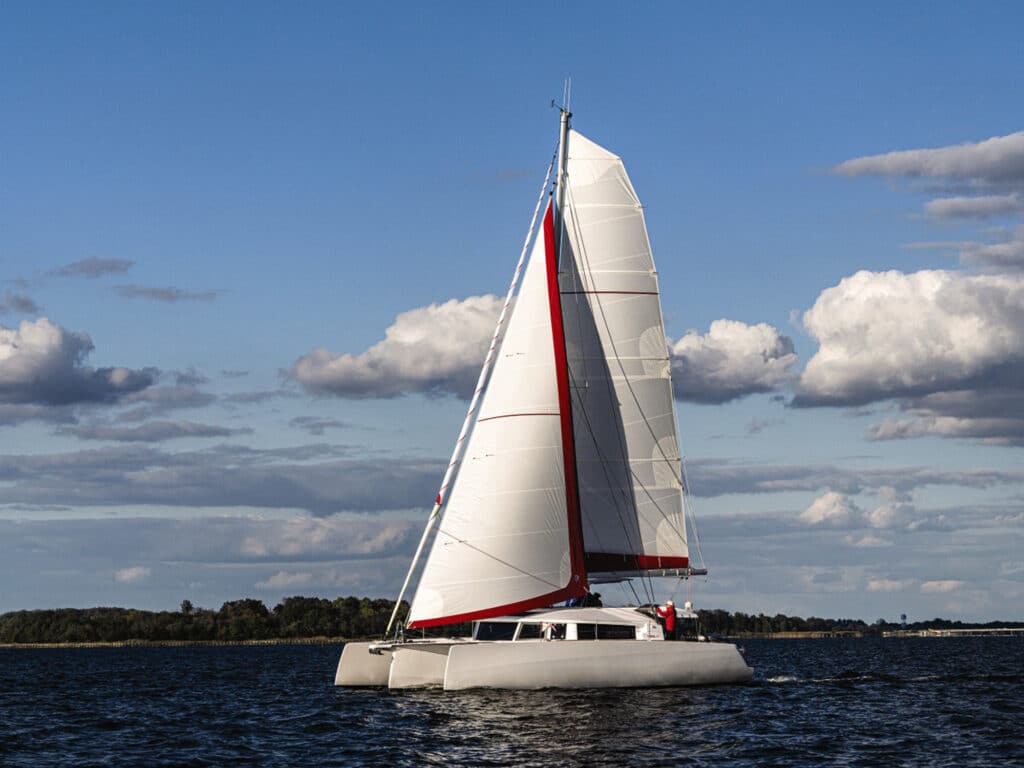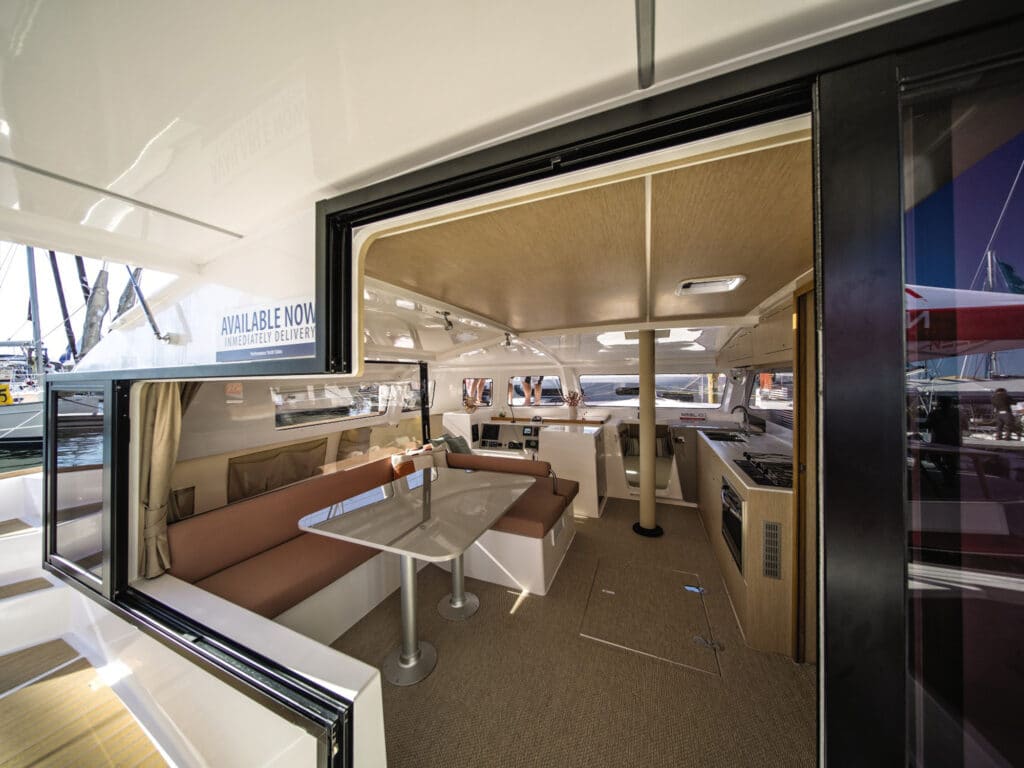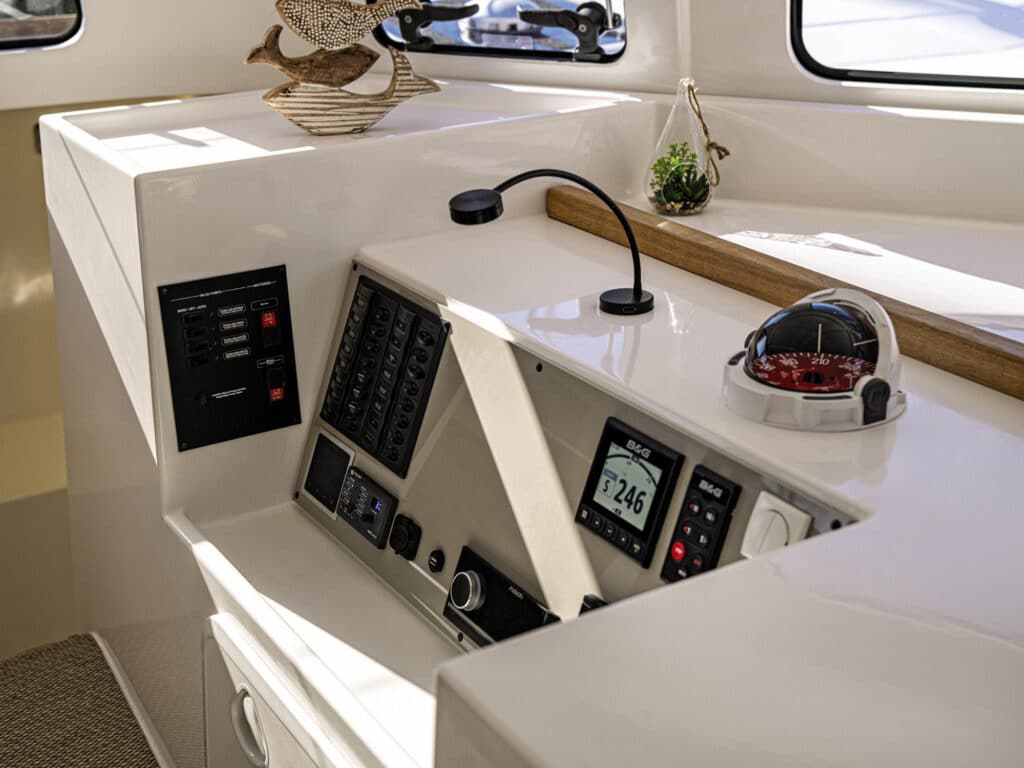
Once the Boat of the Year team was aboard the Neel 43 trimaran and we had the sails set, it didn’t take me long to find my sweet spot. You know, the place you want to sit and watch the miles fly by as the hulls slice through the waves. Nearly every boat I’ve sailed has one, though sometimes it’s hard to find.
But not on the Neel.
With my fellow judges at work at the raised helm station, I stepped from the wheel onto the wide starboard side deck, took a couple of steps down into the cockpit, and wandered into the brightly lit salon where the door to the owner’s cabin was open, as though beckoning in a visitor. Inside, I sat on the edge of the fore-and-aft double berth, set a hand on the bunk, and leaned over to gaze out the long horizontal window, imagining coming off watch and lying there to drift off to sleep. Or waking up in some exotic anchorage, with morning sunlight streaking in. Even dockside, during our preliminary inspection of the boat and a briefing with Neel founder Eric Bruneel, that was the space that caught my eye.
On the inboard side of the stateroom, a long horizontal glass panel covered by an adjustable shade looks in toward the center of the boat and over the inline galley located on the salon’s starboard side. Forward, there are more windows that let you look ahead at where you’re going. Aft, a light-colored wood bulkhead separates the cabin from the head compartment at the rear of the salon. With storage outboard of the berth, it’s a well-laid-out space for living aboard.
Described by Bruneel as a “fast cruiser,” the Neel 43 is designed to sail comfortably at 9 to 10 knots and knock off 250-mile trade-wind days. That description wasn’t far off, from what we saw the day we went sailing on Chesapeake Bay, right after the close of the United States Sailboat Show in Annapolis, Maryland. The wind was light when set out, only about 8 knots, but we hustled right along upwind at 6 to 7 knots with the twin-headsail rig’s smaller inner jib set. Later, with the reaching sail rolled out in just a bit more breeze, we added a knot or more. During my trick on the wheel, I spotted 8.2 knots on the speedo for a spell.
And the sailing was easy, thanks to the buoyancy of the leeward hull that minimizes heel, and the fact that all the weight—engine, tanks, pumps and filters—is located low in the center hull. That, combined with the interior space made possible by spreading accommodations over three hulls, is what makes these trimarans comfortable at sea, Bruneel says.
Neel builds its trimarans at its yard in La Rochelle, France. The 43 is the smallest model in a five-boat range that goes up to 65 feet. The 43 is a Marc Lombard design.

Hulls and deck are made of resin-infused fiberglass with foam coring to save weight. Where practical in nonstructural areas, the yard uses natural fibers such as linen and cork rather than fiberglass, in a push toward greener boatbuilding.
The fit-and-finish of the boat we looked at in Annapolis was noteworthy. The cockpit has a table to port with an L-shaped seating area outboard and aft, located under the Bimini top. To starboard is a grill built into the transom, as well as a cushioned lounging area beneath the helm station.
A wall of glass, with a large opening door and window, spans the aft side of the wide cabin, whose other three sides are lined with ports so that from the interior, one has nearly 360-degree visibility.
A second table is located just inside the salon, to port, also with L-shaped seating. Outboard of it, there’s a guest cabin, separated from the salon by another glass partition.
An additional seating area and nav station equipped with a B&G chart plotter, displays, autopilot control and radio are far forward on the port side of the salon, with the well-appointed galley opposite. A third crew cabin is four steps down, in the forepeak of the center hull.
Beneath the main hull’s sole is an equipment room providing excellent access to the motor (a 50 hp Volvo with saildrive), steering quadrant, systems and electrical boxes—a true engine room, which is hard to find on a boat in this size range.
“It had absolutely the best service access to systems of all the boats we looked at this year,” Boat of the Year judge Ed Sherman noted.
Topside, broad side decks make it easy to move about. There is a wide seat at the helm, with room for three. All sail-control lines run across the cabin top to a bank of line clutches and a pair of winches, all from Antal, that are easily reached while steering. Singlehanding the Neel would not be a problem.

The boat in Annapolis sported an Intracoastal Waterway-friendly 62-foot aluminum spar; a carbon-fiber rig is an option. The boat also came equipped with three 170-watt solar panels and a bow thruster. Loaded with gear, it carried a price tag of $575,000.
Overall, I thought that the Neel’s open-living layout would be just fine for a couple who might have occasional guests aboard for a passage, or a small family with children out for an extended cruise. But I’ll give Boat of the Year judge Herb McCormick the last word here: “It was a remarkably fun and exciting boat to sail, a light and lovely helm. Eric Bruneel has amply demonstrated that if you’re looking to go the multihull route, a trimaran is a viable alternative to a cat.”
Neel 43 Trimaran Specifications
| LOA | 43′ |
|---|---|
| BEAM | 24’7″ |
| DRAFT | 4’11” |
| SAIL AREA | 1,096 sq. ft. |
| DISPLACEMENT | 18,000 lb. |
| D/L | 84 |
| SA/D | 25.5 |
| WATER | 132 gal. |
| FUEL | 80 gal. |
| MAST HEIGHT | 62′ |
| ENGINE | 50 hp Volvo, saildrive |
| DESIGN | Marc Lombard Yacht Design Group |
| PRICE | $575,000 |
| neel-trimarans.com |
Mark Pillsbury, Boat of the Year judge and CW editor-at-large, is a die-hard sailor who has owned a number of sailboats, including a Sabre 34, on which he lived for 15 years.








